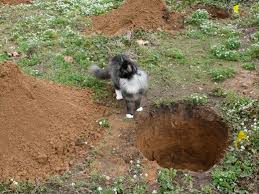If you’re a writer like me, you don’t always anticipate every angle of your story as you draft. Last post we talked about scene cards or story boarding as a way to see your whole story. What do you do when you spot plot holes in your fiction?
Writing Tip for Today: Plot holes often show themselves as you revise for structural problems. Here are some simple ideas on fixing plot holes:
Answer the Why
A plot hole is often an unanswered question. Events, attitudes or actions raise questions in readers’ minds–essential for building and maintaining tension. But sometimes an action or event occurs out of nowhere, popping up faster than a greasy jack-in-the-box taco. If an event or action (or a character’s change of attitude) doesn’t feel logical or needs an explanation, readers will keep wondering about it. If the story item is never explained or feels out of place (or out of character) readers often feel dissatisfied. First, be able to answer the “why” of the situation. Why did character A suddenly disappear from the story? Does the mystery of what a character does or does not do remain unsolved? These “whys” point directly to character motivation. You as storyteller must understand and be able to defend your character’s reasons for both major story actions/attitudes as well as finer details of character. When you’ve answered the whys, then it’s up to you to decide if plugging the hole with the answers enhances the story or if the whole thing is too weak to stay.
Pull the Thread
Other times, plot holes arise after a character, subplot or other story item is introduced but then dropped without resolution. Subplots, in particular, need to have a natural rhythm as they come up in the story and then subside for a time. I often make a scene list and then identify subplots with a color code. I can tell at a glance whether I’ve put too many scenes concerning a subplot too close together or too far apart. Too close and the subplot tends to take over the main story. Too far apart and readers may conclude that it’s unimportant and forget/cease to care about the subplot. If you chart your scenes and identify the subplots (maybe a color for main story and different colors for each subplot) you should see the subplots sort of undulate as they come up and then subside. If an important character is introduced late in the story without any set-up, you can pull the thread through the story by introducing that character earlier (called a plant or foreshadow) and then it will seem more natural to come back to that character. The same is true for actions and attitudes which change or grow. You may need to foreshadow/plant by showing the steps leading to a change in order to pull the thread of change through to the story’s end.
Steps to Decision
In a good story, the main character usually experiences growth or change as part of the arc. We want our characters to be wiser, to gain understanding as they move toward their goal. Yet if one moment the character is 100% against something/someone and the next moment is 100% for that same thing or person, readers will be dissatisfied. We need to see the process by which we make decisions. The larger the decision, the slower the process. In life we agonize over our decisions, and readers want to see characters go through a similar process. Plot holes will appear in your story if you neglect to show readers this process, a wide and risky chasm to force readers to jump across. In general, the sequel is where readers get to view this process: Action is followed by REACTION, INDECISION and finally a DECISION that propels the character to the next ACTION. For minor actions, sequels can be very brief or even implied, but for major story components, readers demand to see how the character gets from one position to another. We want to see characters resist change at first, become confused or question their own position and finally decide (right or wrong) their next move. BIG scenes (especially the climax) should not rush or omit the decision process.See my post about using sequel for more on this topic.






One of the most interesting plot twists/holes I came across — at least I considered it one — was where C, a young man into the theater world, had been declared dead, his family notified, etc. In reality, C had survived the car crash that killed his buddy instead — misidentified body, etc. — and then the survivor (C in fact) disappeared from his hospital room.
So C was missing for over 5 years or so and everyone thought he was dead, until he is later found to be alive and well, living under an alias. (Abducted by the CIA, kept for interrogation during those five years, then given a new identity in exchange for top secret info.) Anyway, in his new identity he meets his girl, but then everyone discovers this man is actually C.
In the last chapter C reveals to his new love that he has all this while owned a restaurant and a theater business. He takes her out to dinner at his restaurant and is shown total respect as the Boss, the man who’s signed their paychecks all these years.
How is it possible to completely disappear, be presumed dead, be held in detention, including vigorous interrogation, by the CIA — and all that time own and operate an active business? Here he turns out to be a wealthy man, even though he was quite young at the time of the accident.
Christine,
I’d say it raises more questions than it answers–while not always bad to leave readers with ??, the main story must be one of these: “C” gets what he wants and is happy, gets what he wants and is NOT happy, doesn’t get what he wants and is happy or unhappy and last, doesn’t care. Unfortunately, I think if I were reading I might think it was too much deus ex machina and I wouldn’t care.
Thanks for your comment!
Keep writing,
Linda
Somehow I had my main character end up at two places at once. I could have–as it’s a fantasy– used a portal, but none of the characters at that time could cast one so that was out. I thought on it for a coupled of weeks, and finally ended up reading from chapter one to the plothole chapter then the rest after it. I ended up (OUCH!) taking out twenty chapters saving them as ‘darlings’ to be recycled in bits and pieces later as need, then re-wrote those twenty chapters to fix that plot hole. It was too confusing trying to edit that many so for me it was ‘easier’ starting from scratch with the reread chapters fresh in my head. Oh lordy, I’m glad I caught it before my wip was finished! Sometimes there’s no easy fix. Had read many how to fix plot hole articles and none of the ideas worked except the nuclear option. @-@ That was not fun, now my patiser butt keeps a loose outline so, I can remember where things are going.
Let me try! C begged the CiA to continue to run his business, they let him go to the restaurant and a theater but with undercover bodyguards, and he has to do as much as he can from home, phone calls, online (if there internet in this world.) Let’s say C agreed to give the CIA this information in exchange for being able to do so. There better? I think that makes sense.